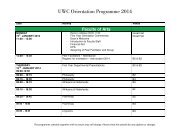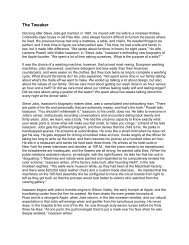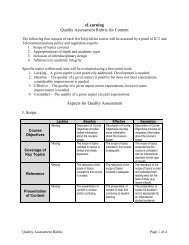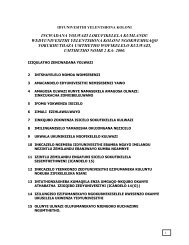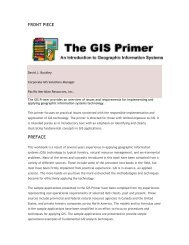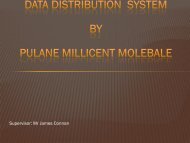Ecosystem Guidelines for Environmental Assessment
Ecosystem Guidelines for Environmental Assessment
Ecosystem Guidelines for Environmental Assessment
Create successful ePaper yourself
Turn your PDF publications into a flip-book with our unique Google optimized e-Paper software.
FRESHWATER<br />
Water quality must be controlled to allow management of wetlands in relation to specific objectives,<br />
e.g. some wetlands may be deemed suitable <strong>for</strong> improving water quality; others would need protection<br />
from pollutants to maintain particular habitat quality.<br />
Hydrological connections between systems should be preserved.<br />
Existing ecosystem linkages/connectivity must be maintained at an appropriate scale.<br />
Buffers (i.e. building setbacks, preferably natural vegetation) should:<br />
- protect wetland systems from specific identified threats, as relevant to each system<br />
- provide sufficient space to allow <strong>for</strong> future rehabilitation and buffering of that ecosystem<br />
- protect the ecosystem health and integrity of receiving ecosystems.<br />
What broad spatial guidelines can be given with respect to<br />
the best approach to development and disturbance<br />
Wetlands should be delineated prior to planning <strong>for</strong> development.<br />
Wetland delineation and assessment should take place during the wet season; the level of confidence<br />
attached to wetland identification and delineation in the dry season is very low <strong>for</strong> all wetlands other<br />
than permanent systems.<br />
Allow adequate buffering of rivers and drainage lines. Ideally, buffer areas should first make allowance<br />
<strong>for</strong> future rehabilitation of the channel - e.g. regrading and reshaping of hardened river banks - and then<br />
impose development setbacks from the theoretical edge of the rehabilitated river bank. The City of Cape<br />
Town's Floodplain Management <strong>Guidelines</strong> 1 should be used as broad guidelines <strong>for</strong> minimum setback<br />
areas. Additional evaluation of specific functional requirements of the buffer areas, on a site-specific<br />
basis, is needed (e.g. providing an appropriate buffer width <strong>for</strong> a system receiving treated effluent<br />
runoff, versus providing an adequate buffer against noise pollution or alien invasion).<br />
Spatial depiction of existing or past linkages between wetlands, drainage channels and rivers/streams<br />
(these should be maintained or restored wherever possible) is required.<br />
Small wetland fragments should be linked by areas of open space; existing drainage lines and<br />
corridors should be conserved; previously disturbed areas should be used, where ecologically appropriate,<br />
<strong>for</strong> per<strong>for</strong>ming "services" such as stormwater treatment, leaving less disturbed areas in a relatively<br />
unimpacted, more isolated condition.<br />
Wetland services usually require a minimum size be<strong>for</strong>e they are effective. Note however that<br />
multiple small systems may nevertheless have an important cumulative effect.<br />
Appropriate unhardened terrestrial open space areas should be used as buffers/interfaces between<br />
developments and wetlands, per<strong>for</strong>ming services such as initial filtration and sedimentation of runoff.<br />
The land-use permitted in these areas should be in accordance with this function. The width of these<br />
buffer areas should be determined with regard to their required functions. Land-uses that potentially<br />
would add nutrients instead of per<strong>for</strong>ming a filtering function would be less appropriate, e.g. grazing<br />
of livestock, development of feedlots or equestrian areas.<br />
What are the critical things to maintain in terms of managing these<br />
systems <strong>for</strong> biodiversity, and ensuring its persistence<br />
Flow regime, including seasonality, water quantity and links to the water table and groundwater system.<br />
Water quality.<br />
Plant communities and habitat structure and zonation - invasion by opportunistic plant species can<br />
occur rapidly and permanently alter habitat quality and availability. Active management against invasion<br />
by opportunistic weeds and other invasive plant species such as bulrush Typha capensis and various<br />
1. City of Cape Town (November 2000) Development Control <strong>Guidelines</strong> <strong>for</strong> Flood-prone Areas<br />
- Draft edition. CCT Catchment, Stormwater and River Management, Catchment Management<br />
Department, Cape Town.<br />
FRESHWATER ECOSYSTEMS - WETLANDS : 71



